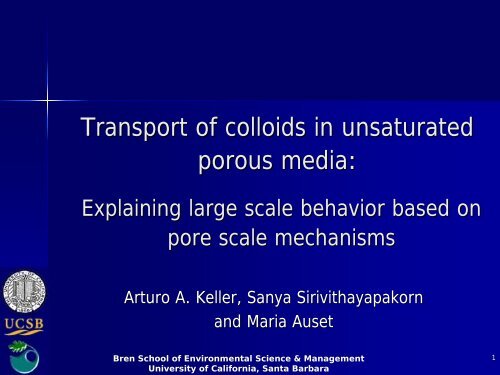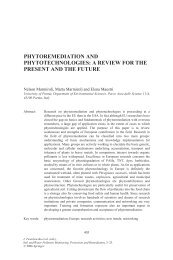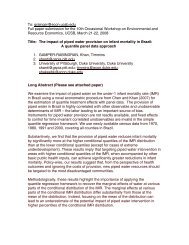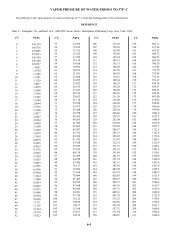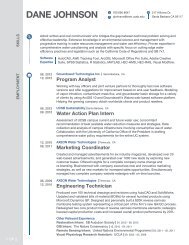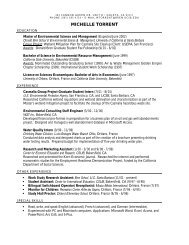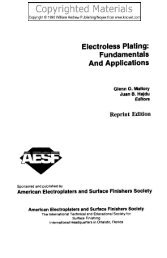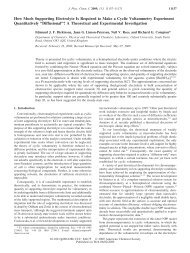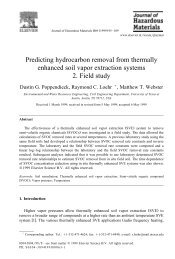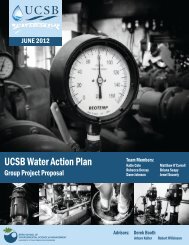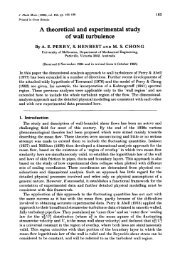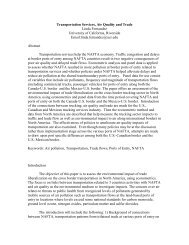Download presentation. - University of California, Santa Barbara
Download presentation. - University of California, Santa Barbara
Download presentation. - University of California, Santa Barbara
You also want an ePaper? Increase the reach of your titles
YUMPU automatically turns print PDFs into web optimized ePapers that Google loves.
Transport <strong>of</strong> colloids in unsaturated<br />
porous media:<br />
Explaining large scale behavior based on<br />
pore scale mechanisms<br />
Arturo A. Keller, Sanya Sirivithayapakorn<br />
and Maria Auset<br />
Bren School <strong>of</strong> Environmental Science & Management<br />
<strong>University</strong> <strong>of</strong> <strong>California</strong>, <strong>Santa</strong> <strong>Barbara</strong><br />
1
Colloids in Groundwater<br />
A B C<br />
50 nm<br />
Photo credit:<br />
A. F.P. Williams, U.S. EPA, http://www.epa.gov/nerlcwww/index.html<br />
B. Nannobacteria Research, http://www.msstate.edu/dept/geosciences/4site/nannobacteria.htm<br />
C. H.D.A Lindquist, U.S. EPA, http://www.epa.gov/nerlcwww/index.html<br />
Bren School <strong>of</strong> Environmental Science & Management<br />
<strong>University</strong> <strong>of</strong> <strong>California</strong>, <strong>Santa</strong> <strong>Barbara</strong><br />
2
Contaminated Supply?<br />
Leaking Sewer line<br />
Or Septic tank<br />
Vadose<br />
Zone<br />
Contaminants<br />
-Viruses<br />
- Bacteria<br />
Saturated<br />
Zone<br />
Bren School <strong>of</strong> Environmental Science & Management<br />
<strong>University</strong> <strong>of</strong> <strong>California</strong>, <strong>Santa</strong> <strong>Barbara</strong><br />
3
Courtesy <strong>of</strong> Bruce Robinson, LANL<br />
Bren School <strong>of</strong> Environmental Science & Management<br />
<strong>University</strong> <strong>of</strong> <strong>California</strong>, <strong>Santa</strong> <strong>Barbara</strong><br />
4
Fate and Transport <strong>of</strong><br />
Colloids<br />
Air<br />
Water<br />
Attached<br />
Inactivated<br />
V<br />
Suspended<br />
Inactivated<br />
Solid<br />
Attached<br />
Inactivated<br />
Bren School <strong>of</strong> Environmental Science & Management<br />
<strong>University</strong> <strong>of</strong> <strong>California</strong>, <strong>Santa</strong> <strong>Barbara</strong><br />
5
Issues<br />
Mobilization <strong>of</strong> colloids during<br />
flushing<br />
Air-Water Interface<br />
Thin-water films<br />
Mobile/Immobile water<br />
Bren School <strong>of</strong> Environmental Science & Management<br />
<strong>University</strong> <strong>of</strong> <strong>California</strong>, <strong>Santa</strong> <strong>Barbara</strong><br />
6
Experimental Setup<br />
Inlet<br />
VCR/monitor<br />
Pressurized<br />
reservoir<br />
Inlet valve<br />
to micromodel<br />
Video<br />
Camer<br />
a<br />
Video image<br />
Pump<br />
PEG*<br />
Micromodel<br />
Microscope<br />
*Polyethylene Glycol Solution<br />
Outlet<br />
PC with video<br />
capture board<br />
Bren School <strong>of</strong> Environmental Science & Management<br />
<strong>University</strong> <strong>of</strong> <strong>California</strong>, <strong>Santa</strong> <strong>Barbara</strong><br />
7
1<br />
2<br />
5<br />
3<br />
4<br />
8<br />
6<br />
7<br />
9<br />
15<br />
16<br />
12<br />
14<br />
10<br />
13<br />
11<br />
1<br />
2<br />
100 µm 100 µm 100 µm 100 µm 100 µm<br />
Bren School <strong>of</strong> Environmental Science & Management<br />
<strong>University</strong> <strong>of</strong> <strong>California</strong>, <strong>Santa</strong> <strong>Barbara</strong><br />
8
1 µm latex spheres at the air-water interface (AWI), X500
MS-2 at the air-water interface (AWI), X1000
Interaction Energy (J)<br />
1.4E-17<br />
1.2E-17<br />
1.0E-17<br />
8.0E-18<br />
6.0E-18<br />
4.0E-18<br />
2.0E-18<br />
0.0E+00<br />
1 um<br />
2um<br />
3 um<br />
0 5 10 15 20<br />
Distance (nm)<br />
3500<br />
3000<br />
2500<br />
2000<br />
1500<br />
1000<br />
500<br />
0<br />
Interaction Energy (kT)<br />
Colloid-colloid interaction in water<br />
(DLVO theory)<br />
Colloid<br />
Distance<br />
Colloid<br />
2.5E-19<br />
60<br />
Interaction Energy (J)<br />
2.0E-19<br />
1.5E-19<br />
1.0E-19<br />
5.0E-20<br />
MS2<br />
0.05 um<br />
50<br />
40<br />
30<br />
20<br />
10<br />
Interaction Energy (kT)<br />
W = V + A vdw<br />
W = Total interaction energy<br />
V = Electrostatic repulsion<br />
A vdw = van der Waals attraction<br />
0.0E+00<br />
0 5 10 15 20<br />
0<br />
Distance (nm)
MS2<br />
0.05µm<br />
Energy Barrier<br />
(DLVO theory)<br />
3 kT<br />
54 kT<br />
1µm 1000 kT<br />
2µm 2100 kT<br />
3µm 3200 kT<br />
Capillary<br />
10 2 kT<br />
10 3 kT<br />
10 5 kT<br />
10 6 kT<br />
10 6 kT<br />
Water Phase<br />
Energy Barrier<br />
Colloid<br />
Colloid<br />
Air-Water<br />
Interface<br />
Air Phase<br />
Capillary<br />
Capillary
Direction <strong>of</strong> flow Water Content: 41%<br />
Bren School <strong>of</strong> Environmental Science & Management<br />
<strong>University</strong> <strong>of</strong> <strong>California</strong>, <strong>Santa</strong> <strong>Barbara</strong><br />
13
First Flush<br />
Water Content: 76%<br />
26 sec after flush<br />
Bren School <strong>of</strong> Environmental Science & Management<br />
<strong>University</strong> <strong>of</strong> <strong>California</strong>, <strong>Santa</strong> <strong>Barbara</strong><br />
14
Water Content: 78%<br />
38 sec after flush<br />
Bren School <strong>of</strong> Environmental Science & Management<br />
<strong>University</strong> <strong>of</strong> <strong>California</strong>, <strong>Santa</strong> <strong>Barbara</strong><br />
15
Water Content:78%<br />
51 sec after flush<br />
Bren School <strong>of</strong> Environmental Science & Management<br />
<strong>University</strong> <strong>of</strong> <strong>California</strong>, <strong>Santa</strong> <strong>Barbara</strong><br />
16
Water Content: 79%<br />
1 min 04 sec after flush<br />
Bren School <strong>of</strong> Environmental Science & Management<br />
<strong>University</strong> <strong>of</strong> <strong>California</strong>, <strong>Santa</strong> <strong>Barbara</strong><br />
17
Water Content: 80%<br />
1min 12 sec after flush<br />
Bren School <strong>of</strong> Environmental Science & Management<br />
<strong>University</strong> <strong>of</strong> <strong>California</strong>, <strong>Santa</strong> <strong>Barbara</strong><br />
18
Water Content: 82%<br />
1min 28 sec after flush<br />
Bren School <strong>of</strong> Environmental Science & Management<br />
<strong>University</strong> <strong>of</strong> <strong>California</strong>, <strong>Santa</strong> <strong>Barbara</strong><br />
19
Water Content: 83%<br />
1min 39 sec after flush<br />
Bren School <strong>of</strong> Environmental Science & Management<br />
<strong>University</strong> <strong>of</strong> <strong>California</strong>, <strong>Santa</strong> <strong>Barbara</strong><br />
20
Water Content: 83%<br />
1min 55 sec after flush<br />
Bren School <strong>of</strong> Environmental Science & Management<br />
<strong>University</strong> <strong>of</strong> <strong>California</strong>, <strong>Santa</strong> <strong>Barbara</strong><br />
21
Water Content: 84%<br />
10 min 09 sec after flush<br />
Bren School <strong>of</strong> Environmental Science & Management<br />
<strong>University</strong> <strong>of</strong> <strong>California</strong>, <strong>Santa</strong> <strong>Barbara</strong><br />
22
Water Content: 68%<br />
2 h 59 min after flush<br />
Bren School <strong>of</strong> Environmental Science & Management<br />
<strong>University</strong> <strong>of</strong> <strong>California</strong>, <strong>Santa</strong> <strong>Barbara</strong><br />
23
Water Content: 62%<br />
3 h 34 min after flush<br />
Bren School <strong>of</strong> Environmental Science & Management<br />
<strong>University</strong> <strong>of</strong> <strong>California</strong>, <strong>Santa</strong> <strong>Barbara</strong><br />
24
Water Content: 58%<br />
3 h 49 min after flush<br />
Bren School <strong>of</strong> Environmental Science & Management<br />
<strong>University</strong> <strong>of</strong> <strong>California</strong>, <strong>Santa</strong> <strong>Barbara</strong><br />
25
Water Content: 55%<br />
4 h 08 min after flush<br />
Bren School <strong>of</strong> Environmental Science & Management<br />
<strong>University</strong> <strong>of</strong> <strong>California</strong>, <strong>Santa</strong> <strong>Barbara</strong><br />
26
Water Content: 47%<br />
4 h 51 min after flush<br />
Bren School <strong>of</strong> Environmental Science & Management<br />
<strong>University</strong> <strong>of</strong> <strong>California</strong>, <strong>Santa</strong> <strong>Barbara</strong><br />
27
Water Content: 43%<br />
5 h 04 min after flush<br />
Bren School <strong>of</strong> Environmental Science & Management<br />
<strong>University</strong> <strong>of</strong> <strong>California</strong>, <strong>Santa</strong> <strong>Barbara</strong><br />
28
Second Flush<br />
11 sec after flush<br />
Bren School <strong>of</strong> Environmental Science & Management<br />
<strong>University</strong> <strong>of</strong> <strong>California</strong>, <strong>Santa</strong> <strong>Barbara</strong><br />
29
13 sec after<br />
second flush<br />
Bren School <strong>of</strong> Environmental Science & Management<br />
<strong>University</strong> <strong>of</strong> <strong>California</strong>, <strong>Santa</strong> <strong>Barbara</strong><br />
30
Water Content: 77%<br />
23 sec after flush<br />
Bren School <strong>of</strong> Environmental Science & Management<br />
<strong>University</strong> <strong>of</strong> <strong>California</strong>, <strong>Santa</strong> <strong>Barbara</strong><br />
31
Water Content: 79%<br />
1 min after flush<br />
Bren School <strong>of</strong> Environmental Science & Management<br />
<strong>University</strong> <strong>of</strong> <strong>California</strong>, <strong>Santa</strong> <strong>Barbara</strong><br />
32
Water Content: 80%<br />
1 min 18 sec after flush<br />
Bren School <strong>of</strong> Environmental Science & Management<br />
<strong>University</strong> <strong>of</strong> <strong>California</strong>, <strong>Santa</strong> <strong>Barbara</strong><br />
33
Water Content: 82%<br />
1 min 35 sec after flush<br />
Bren School <strong>of</strong> Environmental Science & Management<br />
<strong>University</strong> <strong>of</strong> <strong>California</strong>, <strong>Santa</strong> <strong>Barbara</strong><br />
34
Water Content: 83%<br />
2 min after flush<br />
Bren School <strong>of</strong> Environmental Science & Management<br />
<strong>University</strong> <strong>of</strong> <strong>California</strong>, <strong>Santa</strong> <strong>Barbara</strong><br />
35
Water Content: 85%<br />
2 min 28 sec after flush<br />
Bren School <strong>of</strong> Environmental Science & Management<br />
<strong>University</strong> <strong>of</strong> <strong>California</strong>, <strong>Santa</strong> <strong>Barbara</strong><br />
36
Water Content: 87%<br />
5 min 49 sec after flush<br />
Bren School <strong>of</strong> Environmental Science & Management<br />
<strong>University</strong> <strong>of</strong> <strong>California</strong>, <strong>Santa</strong> <strong>Barbara</strong><br />
37
Key Findings<br />
Sorption onto AWI is “irreversible”<br />
Colloids sorbed onto AWI can form clusters<br />
Colloids trapped in thin water films<br />
Colloids sorbed onto AWI can be transported<br />
Along with the moving air bubble<br />
As colloidal clusters<br />
As water is remobilized<br />
Bren School <strong>of</strong> Environmental Science & Management<br />
<strong>University</strong> <strong>of</strong> <strong>California</strong>, <strong>Santa</strong> <strong>Barbara</strong><br />
38
Pressure<br />
Transducers<br />
Data Acquisition<br />
System<br />
Injection<br />
Port<br />
Flow<br />
Meter<br />
Pump<br />
Water<br />
Reservoir<br />
Unsaturated<br />
Column<br />
Setup<br />
Sample<br />
Collection<br />
Bren School <strong>of</strong> Environmental Science & Management<br />
<strong>University</strong> <strong>of</strong> <strong>California</strong>, <strong>Santa</strong> <strong>Barbara</strong><br />
39
C/Co, KCl<br />
C/Co, KCl<br />
C/Co, KCl<br />
0.8<br />
0.7<br />
0.6<br />
0.5<br />
0.4<br />
0.3<br />
0.2<br />
0.1<br />
KCl<br />
MS2<br />
0.05 um 3 um<br />
0.18<br />
0.16<br />
0.14<br />
0.12<br />
0.10<br />
0.08<br />
0.06<br />
0.04<br />
0.02<br />
0.0<br />
0.00<br />
0.0 0.5 1.0 1.5 2.0 2.5<br />
0.8<br />
0.18<br />
KCl<br />
MS2<br />
0.7<br />
0.05 um 3 um 0.16<br />
0.6<br />
0.5<br />
0.4<br />
0.3<br />
0.2<br />
0.1<br />
0.14<br />
0.12<br />
0.10<br />
0.08<br />
0.06<br />
0.04<br />
0.02<br />
0.0<br />
0.00<br />
0.0 0.5 1.0 1.5 2.0 2.5<br />
0.8<br />
0.18<br />
KCl<br />
MS2<br />
0.7<br />
0.05 um 3 um 0.16<br />
0.6<br />
0.5<br />
0.4<br />
0.3<br />
0.2<br />
0.1<br />
0<br />
0.0 0.5 1.0 1.5 2.0 2.5<br />
Pore volume<br />
0.14<br />
0.12<br />
0.10<br />
0.08<br />
0.06<br />
0.04<br />
0.02<br />
0.00<br />
C/Co, Colloids<br />
C/Co, Colloids<br />
C/Co, Colloids<br />
S w = 44%<br />
S w = 37%<br />
S w = 27%<br />
Breakthrough<br />
curves<br />
for<br />
steady water<br />
contents
θ<br />
0.1 0<br />
0.45<br />
0.40<br />
0.4 5<br />
0.4 0<br />
0.3 5<br />
0.3 0<br />
0.2 5<br />
0.2 0<br />
0.1 5<br />
-4<br />
60<br />
0<br />
Time (min)<br />
Z = 5 cm<br />
Z = 15 cm<br />
Z = 25 cm<br />
Z = 35 cm<br />
Z = 45 cm<br />
Z = 55 cm<br />
MS2<br />
0.05um<br />
3um<br />
Water content, θ, (cm -3 -cm -3 )<br />
Water content, θ, (cm -3 -cm -3 )<br />
0.40<br />
0.35<br />
0.35<br />
0.30<br />
0.25<br />
0.30<br />
0.20<br />
0.25<br />
0.15<br />
0.20<br />
0.10<br />
0.15<br />
0.05<br />
0.10<br />
0.00<br />
0<br />
0.45<br />
10 20 30 40 50 60<br />
0.40<br />
0.40<br />
0.35<br />
0.35<br />
0.30<br />
0.25<br />
0.30<br />
0.20<br />
0.25<br />
0.15<br />
0.20<br />
0.10<br />
0.15<br />
0.05<br />
0.10<br />
0.00<br />
0.45<br />
0 10 20 30 40 50 60<br />
0.40<br />
C/Co<br />
C/Co<br />
S w,i<br />
= 44%<br />
S w,i<br />
= 37%<br />
BT curves<br />
during<br />
flushing<br />
Peak <strong>of</strong> BT-curves appear<br />
immediately after column is<br />
saturated<br />
0.40<br />
0.35<br />
Water content, θ, (cm -3 -cm -3 )<br />
0.35<br />
0.30<br />
0.25<br />
0.20<br />
0.15<br />
0.30<br />
0.25<br />
0.20<br />
0.15<br />
0.10<br />
0.05<br />
C/Co<br />
S w,i<br />
27%<br />
0.10<br />
0 10 20 30 40 50 60<br />
Time (min)<br />
0.00
Mass recovered (%)<br />
40<br />
30<br />
20<br />
10<br />
MS2<br />
Steady Flushing Total<br />
<br />
Steady water content<br />
<br />
Colloid recovery<br />
Recovery <strong>of</strong><br />
0<br />
0.11 0.15 0.18<br />
MS2>0.05mm>3mm<br />
Mass recovered (%)<br />
40<br />
30<br />
20<br />
10<br />
0.05 µm<br />
Steady Flushing Total<br />
<br />
<br />
Recovery increases with<br />
water content<br />
Flushing<br />
<br />
Much higher recovery<br />
Mass recovered (%)<br />
0<br />
40<br />
30<br />
20<br />
10<br />
0<br />
3 µm<br />
0.11 0.15 0.18<br />
Steady Flushing Total<br />
0.11 0.15 0.18<br />
<br />
<br />
Peak <strong>of</strong> BT-curves appear<br />
immediately after column is<br />
saturated<br />
Recovery decreases<br />
significantly with increase<br />
initial water content<br />
Initial water content (cm -3 -cm -3 )
Connection to larger scale<br />
Under unsaturated conditions, steady-state state water<br />
content, slow flow<br />
Colloid breakthrough is low due to sorption at AWI<br />
Sorption to solid interface can be significant due to low<br />
flowrates<br />
Colloids trapped in immobile water<br />
Flushing releases colloids:<br />
Sorbed<br />
Remobilized with water<br />
In clusters<br />
Bren School <strong>of</strong> Environmental Science & Management<br />
<strong>University</strong> <strong>of</strong> <strong>California</strong>, <strong>Santa</strong> <strong>Barbara</strong><br />
43
Conclusions<br />
Significant storage <strong>of</strong> colloids under<br />
unsaturated conditions<br />
Modelling <strong>of</strong> vadose zone transport is<br />
important to understand the risk <strong>of</strong><br />
mobilization<br />
Understanding pore-scale mechanisms can<br />
help guide larger-scale experiments<br />
produce better models<br />
Bren School <strong>of</strong> Environmental Science & Management<br />
<strong>University</strong> <strong>of</strong> <strong>California</strong>, <strong>Santa</strong> <strong>Barbara</strong><br />
44
Acknowledgements<br />
Funding from UCSB Academic Senate<br />
Committee on Research<br />
Bren School <strong>of</strong> Environmental Science & Management<br />
<strong>University</strong> <strong>of</strong> <strong>California</strong>, <strong>Santa</strong> <strong>Barbara</strong><br />
45


